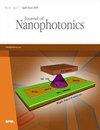卵黄壳纳米结构光学性质的模拟
IF 1.1
4区 物理与天体物理
Q4 NANOSCIENCE & NANOTECHNOLOGY
引用次数: 0
摘要
摘要卵黄壳结构是由壳、腔和核组成的双层中空纳米结构。卵黄壳结构由于其吸引人的局域表面等离子体共振(LSPR)特征而具有迷人的性质,这引起了人们对光学活性纳米结构和实际应用的极大兴趣。与单一金属纳米结构相比,蛋黄壳具有更可控的自由度、优越的光学性能,在光催化和太阳能电池中具有潜在的应用前景。然而,蛋黄壳的制备往往需要多个步骤,难以准确控制几何参数,导致实验结果无法控制。因此,有必要研究蛋黄壳的大小和组成如何影响LSPR的性能,以进一步指导和优化实验过程。基于离散偶极近似(DDA)方法,分析了蛋黄壳纳米粒子的吸收光谱、近场增强和传感特性。通过调整腔、核、壳的直径和壳的材料,我们研究了蛋黄壳结构对LSPR性能的影响。具体地,壳的厚度设定为5至20nm,空腔的直径设定为50至70nm,蛋黄的直径设定为由20至40nm。壳的材料被设置为电介质TiO2和金属Au,并且它们都具有Au核。发现Au@Au具有大空腔或厚壳的蛋黄壳具有更好的吸收效率,但Au @ TiO2蛋黄壳正好相反。对于近场强度,Au@Au蛋黄壳比Au高 @ 具有较大空腔的蛋黄壳结构在最大一半处具有较小的全宽。这些结果可以有效地指导基于LSPR的传感和光电应用蛋黄壳结构的设计。本文章由计算机程序翻译,如有差异,请以英文原文为准。
Simulation of yolk-shell nanostructures optical properties
Abstract. A yolk-shell structure is a double-layer hollow nanostructure, which is composed of a shell, a cavity, and a core. The yolk-shell structures have fascinating properties because of their attractive localized surface plasmon resonance (LSPR) feature, which arouses considerable interest in both optically active nanostructures and practical applications. Compared with the single metal nanostructure, a yolk shell has a more controlled degree of freedom, superior optical properties, and potential applications in photocatalysis and solar cell. However, the preparation of yolk shells often requires multiple steps, making it difficult to control the geometric parameters accurately, which leads to uncontrollability of the experimental results. Therefore, it is necessary to study how the size and composition of a yolk shell affect LSPR properties to further guide and optimize the experimental process. Based on the discrete dipole approximation (DDA) method, the absorption spectra, near-field enhancement, and sensing properties of yolk-shell nanoparticles were analyzed. By adjusting the diameters of cavities, cores, shells, and the materials of the shells, we study the influence of yolk-shell structures on the LSPR properties. In detail, the thicknesses of the shells are set from 5 to 20 nm, the diameters of the cavities being set from 50 to 70 nm and the diameters of the yolks are set from 20 to 40 nm. The materials of the shells are set to be dielectric TiO2 and metallic Au, and both of them have Au cores. It is found that Au@Au yolk shells with large cavities or thick shells have better absorption efficiency, but Au @ TiO2 yolk shells are just the opposite. For near-field intensity, Au@Au yolk shells are higher than Au @ TiO2. A yolk-shell structure with larger cavity has smaller full width at half maximum. These results can effectively guide the design of yolk-shell structures for sensing and optoelectronic applications based on LSPR.
求助全文
通过发布文献求助,成功后即可免费获取论文全文。
去求助
来源期刊

Journal of Nanophotonics
工程技术-光学
CiteScore
2.60
自引率
6.70%
发文量
42
审稿时长
3 months
期刊介绍:
The Journal of Nanophotonics publishes peer-reviewed papers focusing on the fabrication and application of nanostructures that facilitate the generation, propagation, manipulation, and detection of light from the infrared to the ultraviolet regimes.
 求助内容:
求助内容: 应助结果提醒方式:
应助结果提醒方式:


